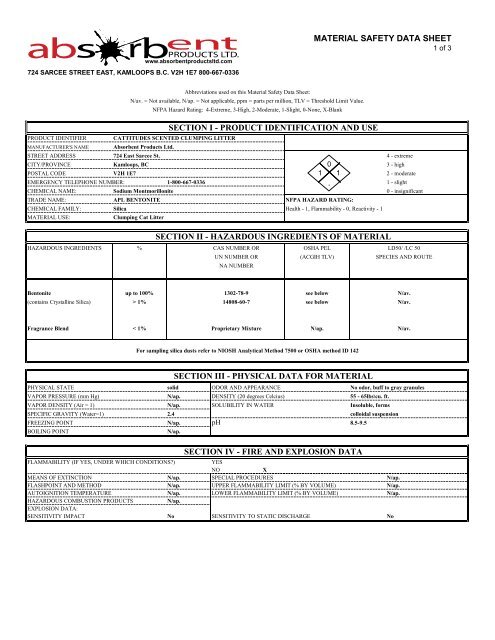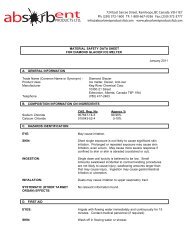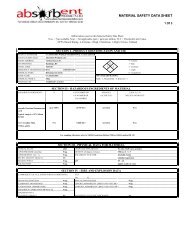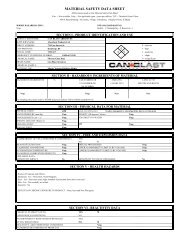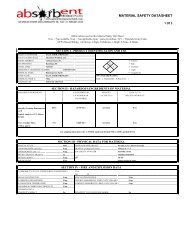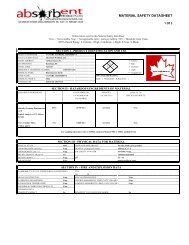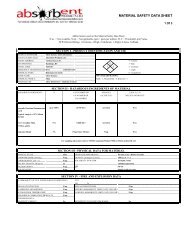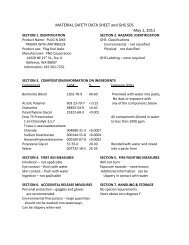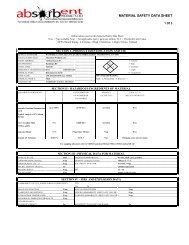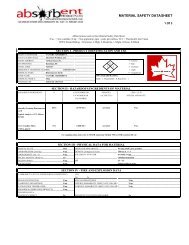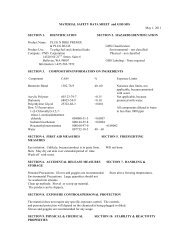MSDS - Cattitudes Clumping Scented Cat Litter - Absorbent ...
MSDS - Cattitudes Clumping Scented Cat Litter - Absorbent ...
MSDS - Cattitudes Clumping Scented Cat Litter - Absorbent ...
Create successful ePaper yourself
Turn your PDF publications into a flip-book with our unique Google optimized e-Paper software.
MATERIAL SAFETY DATA SHEET<br />
1 of 3<br />
www.absorbentproductsltd.com<br />
724 SARCEE STREET EAST, KAMLOOPS B.C. V2H 1E7 800-667-0336<br />
Abbreviations used on this Material Safety Data Sheet:<br />
N/av. = Not available, N/ap. = Not applicable, ppm = parts per million, TLV = Threshold Limit Value.<br />
NFPA Hazard Rating: 4-Extreme, 3-High, 2-Moderate, 1-Slight, 0-None, X-Blank<br />
SECTION I - PRODUCT IDENTIFICATION AND USE<br />
PRODUCT IDENTIFIER CATTITUDES SCENTED CLUMPING LITTER<br />
MANUFACTURER'S NAME <strong>Absorbent</strong> Products Ltd.<br />
STREET ADDRESS 724 East Sarcee St. 4 - extreme<br />
CITY/PROVINCE Kamloops, BC 0<br />
3 - high<br />
POSTAL CODE V2H 1E7 1 1<br />
2 - moderate<br />
EMERGENCY TELEPHONE NUMBER: 1-800-667-0336 1 - slight<br />
CHEMICAL NAME: Sodium Montmorillonite 0 - insignificant<br />
TRADE NAME: APL BENTONITE NFPA HAZARD RATING:<br />
CHEMICAL FAMILY: Silica Health - 1, Flammability - 0, Reactivity - 1<br />
MATERIAL USE:<br />
<strong>Clumping</strong> <strong>Cat</strong> <strong>Litter</strong><br />
SECTION II - HAZARDOUS INGREDIENTS OF MATERIAL<br />
HAZARDOUS INGREDIENTS % CAS NUMBER OR OSHA PEL LD50/ /LC 50<br />
UN NUMBER OR (ACGIH TLV) SPECIES AND ROUTE<br />
NA NUMBER<br />
.<br />
Bentonite up to 100% 1302-78-9 see below N/av.<br />
(contains Crystalline Silica) > 1% 14808-60-7 see below N/av.<br />
Fragrance Blend < 1% Proprietary Mixture N/ap. N/av.<br />
For sampling silica dusts refer to NIOSH Analytical Method 7500 or OSHA method ID 142<br />
SECTION III - PHYSICAL DATA FOR MATERIAL<br />
PHYSICAL STATE solid ODOR AND APPEARANCE No odor, buff to gray granules<br />
VAPOR PRESSURE (mm Hg) N/ap. DENSITY (20 degrees Celcius) 55 - 65lbs\cu. ft.<br />
VAPOR DENSITY (Air = 1) N/ap. SOLUBILITY IN WATER Insoluble, forms<br />
SPECIFIC GRAVITY (Water=1) 2.4 colloidal suspension<br />
FREEZING POINT N/ap. pH 8.5-9.5<br />
BOILING POINT<br />
N/ap.<br />
SECTION IV - FIRE AND EXPLOSION DATA<br />
FLAMMABILITY (IF YES, UNDER WHICH CONDITIONS?)<br />
YES<br />
NO<br />
X<br />
MEANS OF EXTINCTION N/ap. SPECIAL PROCEDURES N/ap.<br />
FLASHPOINT AND METHOD N/ap. UPPER FLAMMABILITY LIMIT (% BY VOLUME) N/ap.<br />
AUTOIGNITION TEMPERATURE N/ap. LOWER FLAMMABILITY LIMIT (% BY VOLUME) N/ap.<br />
HAZARDOUS COMBUSTION PRODUCTS<br />
N/ap.<br />
EXPLOSION DATA:<br />
SENSITIVITY IMPACT No SENSITIVITY TO STATIC DISCHARGE No
MATERIAL SAFETY DATA SHEET<br />
2 of 3<br />
MATERIAL IDENTIFIER:<br />
CATTITUDES CLUMPING LITTER SCENTED<br />
SECTION V - HEALTH HAZARDS<br />
Routes of Exposure and Effects:<br />
Inhalation: Acute (short term) exposure to dust levels exceeding the PEL may cause irritation of respiratory tract resulting in a dry cough. Chronic (long term) exposure to crystalline<br />
free silica contained by airborne bentonite dust where levels are higher than TLV's may lead to the development of silicosis or other respiratory problems. Persistent dry cough, throat<br />
irritation and labored breathing on exertion are symptomatic. Exposure may aggravate existing upper respiratory tract diseases such as asthma, bronchitis or emphysema.<br />
Eyes: Irritant.<br />
Skin: Possible drying results in dermatitis.<br />
Ingestion: No adverse effects.<br />
Permissible Exposure Limits: OSHA PEL ACGIH OHS OHS STEL<br />
(for airborne, nuisance dusts) 8 hr TWA TLV 8 hr TWA<br />
Silica, Amorphous<br />
Total dust 15 mg/m 3 Not detected 4 mg/m 3 n/a<br />
Respirable dust 1.5 mg/m 3 Not detected 1.5 mg/m 3 n/a<br />
Crystalline, crystobalite 0.05 mg/m 3 0.05 mg/m 3 0.025mg/m 3 n/a<br />
EFFECTS OF CHRONIC EXPOSURE TO PRODUCT<br />
Exposure to quantities of crystalline silica dust, in the forms of quartz, cristobalite or tridymite, may be present in airborne dust. If the concentration levels are in excess of the OSHA<br />
Permissible Limit (PEL-TWA 8hrs) of 0.05mg/m3 or the ACGIH Threshold Limit Value (TLV) of 0.05mg/m3, the crystalline silica is a known cause of silicosis, a progressive, sometimes<br />
fatal, lung disease. From the International Agency for Research on Cancer (IARC), a 1997 review of "Crystalline Silica Inhaled in the Form of Quartz or Cristobalite" coded Monograph 68<br />
concluded that Amorphous Silica is not classifiable to its carcinogenicity to humans (Group 3)<br />
.<br />
SECTION VI - REACTIVITY DATA<br />
CHEMICAL STABILITY (IF NO, YES X<br />
UNDER WHICH CONDITIONS)<br />
INCOMPATIBILITY WITH OTHER SUBSTANCES YES X Hydrofluoric acid - silica may react violently<br />
(IF YES, WHICH ONES)<br />
REACTIVITY, AND UNDER WHAT CONDITIONS<br />
HAZARDOUS DECOMPOSITION PRODUCTS<br />
NO<br />
NO<br />
N/ap.<br />
N/ap.<br />
SECTION VII - PRECAUTIONS FOR SAFE HANDLING AND USE<br />
PERSONAL PROTECTIVE EQUIPMENT<br />
Bureau of Mines or NIOSH approved respirators for protection against pneumoconiosis producing dusts recommended when dust is present. If the dust concentration is less than ten<br />
(10) times the Permissible Exposure Limit (PEL) use quarter or half mask respirator with replacement dust filter or single use dust respirator with valve. If dust concentration is greater<br />
than ten (10) times and less than one hundred (100) times the PEL use full faceplate respirator with replaceable dust filter; if greater than one hundred (100) and less than two hundred<br />
(200) times the PEL use power air purifying (positive pressure) respirator with replaceable filter; if greater than two hundred (200) times the PEL use type C, automatic-air respirator,<br />
continuous flow type (positive pressure), with full face piece, head or helmet.<br />
GLOVES (SPECIFY)<br />
RESPIRATOR (SPECIFY)<br />
EYE (SPECIFY)<br />
FOOTWEAR (SPECIFY)<br />
Not needed under normal conditions of use.<br />
Avoid breathing dust. Use respirators approved NIOSH/OSHA for silica bearing dust.<br />
Use protective goggles in high dust conditions.<br />
As required on jobsite.
MATERIAL SAFETY DATA SHEET<br />
3 of 3<br />
MATERIAL IDENTIFIER:<br />
CATTITUDES CLUMPING LITTER SCENTED<br />
SECTION VII - PRECAUTIONS FOR SAFE HANDLING AND USE CONTINUED<br />
CLOTHING (SPECIFY)<br />
Wear coveralls in high dust conditions.<br />
ENGINEERING CONTROLS (SPECIFY, E.G. VENTILATION, ENCLOSED PROCESS)<br />
Local - control within recommended TLV/PEL, mechanical filtration to minimize dust. Refer to ACGIH publication "Industrial<br />
Ventilation" or similar publications for design of ventilation systems.<br />
LEAK AND SPILL PROCEDURE<br />
Vacuum clean spillage, wet sweep or wash away. Avoid creating dust.<br />
WASTE DISPOSAL<br />
Dispose of in accordance with local, state and federal regulations.<br />
HANDLING PROCEDURES<br />
Avoid creating dust. Repair or properly dispose of broken bags. Use wet process or enclosed handling.<br />
STORAGE REQUIREMENTS<br />
Store in a dry place to maintain product quality. Keep containers closed and in good condition. Repair damaged containers.<br />
SPECIAL SHIPPING INFORMATION<br />
None<br />
SECTION VIII - FIRST AID MEASURES<br />
SPECIFIC MEASURES<br />
Inhalation: Remove victim to fresh air. If breathing has stopped, a trained person should perform artificial respiration.<br />
Acute inhalation can cause dryness of the nasal passage and congestion of the upper respiratory tract.<br />
Ingestion: Do not induce vomiting. Short-term exposure not considered harmful. Drink generous amounts of water to<br />
reduce bulk and drying effects.<br />
Eye: Wash with generous quantities of water. Consult physician if irritation persists. May cause irritation or inflammation.<br />
Skin contact: Remove contaminated clothing. Wash with soap and water until clean. Use moisture renewing lotions<br />
if dryness occurs. Not absorbed by the skin. May cause dryness.<br />
SECTION IX - DEPARTMENT OF TRANSPORTATION<br />
HAZARDOUS MATERIALS DESCRIPTION: None IDENTIFICATION NUMBER: None<br />
TECHNICAL NAME: None LABEL(S) REQUIRED: None<br />
HAZARDOUS CLASS:<br />
None<br />
EMERGENCY PLANNING AND COMMUNITY RIGHT TO KNOW INFORMATION<br />
SECTION X - ENVIRONMENTAL DATA<br />
This product contains no toxic chemicals subject to the reporting requirements of section 313 of Title III of the Superfund Amendments and Reauthorization Act of 1986 and 40 CFR<br />
Part 372 (SARA 313 - Toxic Chemical Release Reporting).<br />
EPA SARA 311/312 Hazard Classification: This product is considered hazardous under OSHA and SARA Title III, Section 301. <strong>Cat</strong>egory: Chronic Health.<br />
CERCLA Section 103: This product is not subject to CERCLA reporting requirements as it is sold. Refer to CERCLA regulations to determine if used product mixed with other<br />
chemicals or materials may be reportable. Many states have more stringent release reporting requirements. Reports spills required under federal, state and local regulations.<br />
EPZ Toxic Substance Control Act (TSCA): All of the ingredients are listed on the TSCA Chemical Substances Inventory.<br />
DOT Marine Pollutants: This product does not contain Marine Pollutants as defined in 49 CFR 171.8.<br />
SECTION XI - PREPARATION DATE OF <strong>MSDS</strong><br />
PREPARED BY: PHONE NUMBER DATE<br />
Quality Control Staff, <strong>Absorbent</strong> Products Ltd. 1-800-667-0336 May, 2013<br />
All information presented herein is believed to be accurate; however, it is the user's responsibility to determine in advance of need that the information is current and suitable for their circumstances. No warranty or guarantee, expressed or implied<br />
is made by Western <strong>Absorbent</strong> Industrial Products Clay Ltd., Products as to the Ltd., information, as to the information, as to the safety, or as toxicity the safety, or the toxicity effect of or this the product. effect of this product.


